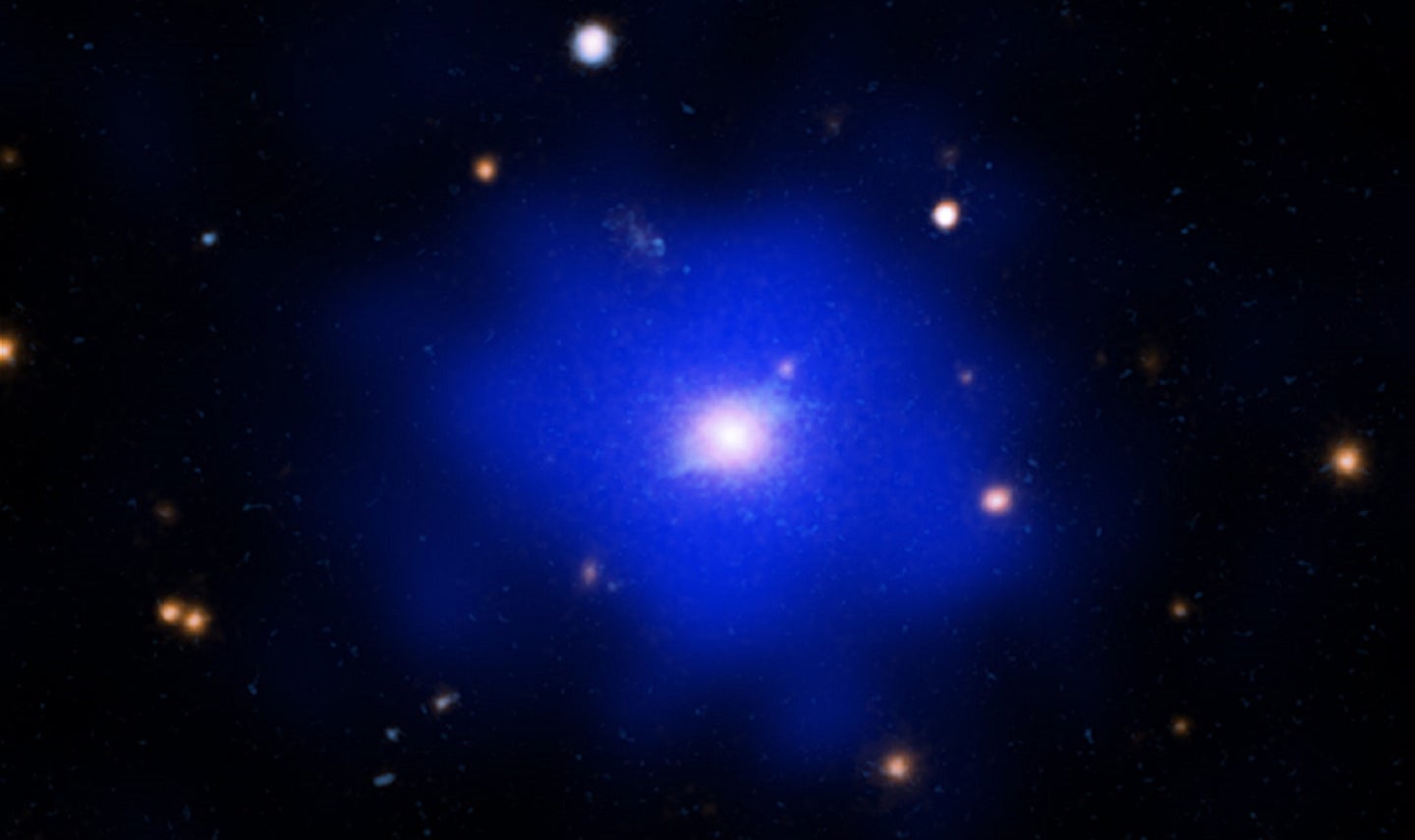Secrets of the early universe are hidden in this chill galaxy cluster
Astronomers used the afterglow of the big bang, hungry supermassive black holes, and space telescopes to find a rare 'relaxed' galaxy cluster.

The early universe was a stressful place for galaxies. Globs of tens to hundreds of neighboring galaxies, called galaxy clusters, would share a communal pool of hot gas—but not without drama. There was always another wayward galaxy crashing into the cluster, merging with one of the former occupants, and generally perturbing the gas pool, known as the intracluster medium.
That’s what makes the newly discovered galaxy cluster SPT2215 so special. Found about 8.4 billion-light years from Earth, astronomers recently captured views of SPT2215 as it existed when the universe was just 5 billion years old. On further study, they’ve deemed it one of the few “relaxed” galaxy clusters found from that period in the cosmos. It could lead scientists to revise how their models of how fast galaxies formed at the dawn of the universe.
[Related: These 6 galaxies are so huge, they’ve been nicknamed ‘universe breakers’]
“If the galaxy cluster is in the process of forming, we call it ‘disturbed’—it’s just kind of a mess,” says Michael Calzadilla, a PhD candidate in astrophysics at MIT and lead author of an April 19 paper in The Astrophysical Journal characterizing the newly discovered SPT2215 cluster with the help of multiple telescopes and flying observatories.
“If the gas is very round, very symmetrical, and looks kind of like a ball, it tells you that there haven’t been any recent interactions,” he says. “It’s very ‘relaxed.’” In other words, there are no galaxy mergers disrupting things, which seems to be the case with SPT2215.
Finding and studying relaxed galaxy clusters from the early universe can give astronomers clues to how galaxy and star formation differed between eight billion years ago and today. The discovery of SPT2215, however, came about unlike that of any other galaxy cluster. It began with an interesting shadow of microwave frequencies and ended with a bizarre thermostat reading.
An international team of dozens of scientists went looking for signs of distant galaxy clusters in the SPTpol Extended Cluster Survey, which uses the Sunyaev–Zel’dovich effect—the cosmic microwave background interacting with the hot communal gas from galaxies—to find relevant groups of stars.
The cosmic microwave background is the first light in the universe, a.k.a. the afterglow of the big bang, Cazadilla notes. When low-energy microwave photons encounter a galaxy cluster on their way to Earth, they’re scattered to higher energies by the gas, or the plasma inside of the galaxy cluster,” he says. The gaps left behind by those amped-up photons show up as shadows against the cosmic microwave background, giving a rough idea of where the cluster is. From there, astronomers have to do follow-up observations to tell the distance, and whether the cluster is disturbed or relaxed. In the case of SPT2215, Calzadilla and his colleagues used a collection of instruments including the Hubble Space Telescope, the infrared Spitzer Telescope, the Chandra X-ray observatory, and ground-based telescopes like the Giant Magellan Telescope in Chile.
”You get more of the whole picture of what’s going on if you look at different wavelengths,” Calzadilla says. “Chandra is looking at X-ray wavelengths; Spitzer is looking at infrared wavelengths; and Hubble is looking at optical wavelengths that are kind of in the middle.”
The intracluster gas of a galaxy cluster typically cools over time, first emitting X-rays, then cooling to emit ultraviolet light, and finally, emitting electromagnetic wavelengths down to the infrared region, he explains. “We can catch each part of this process at different wavelengths, using these different telescopes.”
[Related: How a microwave helped astronomers solve the peryton mystery]
Normally, the cooling gas shared in a galaxy cluster slowly falls inward, forming and feeding a central galaxy that tends to dominate the others, Calzadilla says. The gas sustains star birth in that central galaxy, but also fuels the creation of a supermassive black hole at that galaxy’s center. When feeding, supermassive black holes will generate energetic outbursts, which push back against the cooling and inflating gas.
“It acts as a thermostat and regulates the temperature, in a sense of the galaxy cluster,” Calzadilla notes, slowing down the rate at which the gas cools.
But what’s interesting about SPT2215, he adds, is that “it looks like that thermostat is having a hard time keeping up with the amount of cooling that’s going on.” That gives it a chillier aura than expected (starting at around 179,540 degrees Fahrenheit), with the gas being projected to cool much faster than in most other galaxy clusters found at a similar time in the universe. The central galaxy also exhibits more new, young stars than a cluster where a black hole kept the gas from cooling too quickly.
Calzadilla thinks there could be a variety reasons SPT2215 is so cool, including the possibility “that maybe the black hole has only just now been turned on. It it takes a while for this cooling gas to make it to the central galaxy and into that black hole.”
While it would take further observations, perhaps with the James Webb Space Telescope or longer follow-ups with Hubble, to know for certain, “[SPT2215] could be telling us that galaxies are forming at a younger age than we thought,” in the early universe, Calzadilla says. “That’s challenging our timeline of when things happened.”